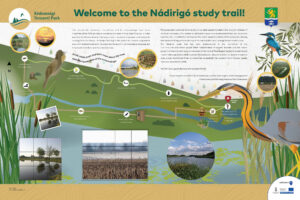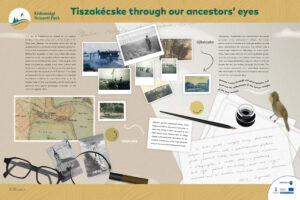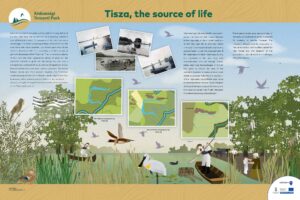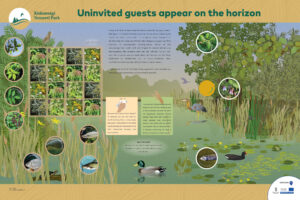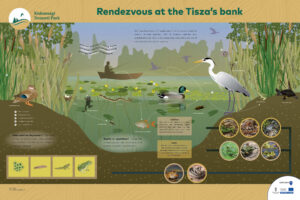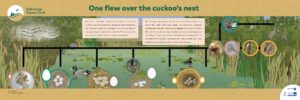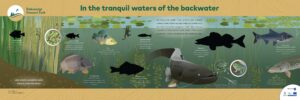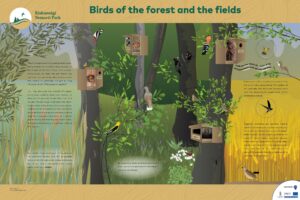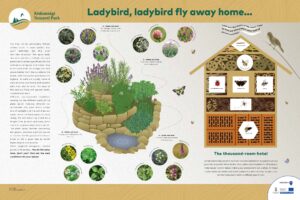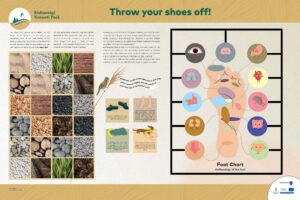TISZAKÉCSKE
INTERACTIVE STUDY TRAIL
The Tisza backwater in Tiszakécske is a nature conservation area of local significance
The body of representatives of Tiszakécske have declared the backwater located here and its surroundings in 2016 a locally protected nature conservation area (locally protected area for short), extending over an area of 180 ha, of which the backwater system occupies about 100 ha. Its parkland is a popular recreation area, and internationally renowned site among anglers, as well as an area of nature conservation and welfare functions.
The backwater here (an oxbow lake) was created by natural formation, and is already indicated as a separate body of water on Military map I (1763-86). By now, the backwater has been divided into four sections with transverse embankments.
The backwater is a recipient of local precipitation waters. Its refill from and drainage to the Tisza river takes place through channels. The habitats of the Tisza backwater in Tiszakécske include elements of lacustrine-swamp plant associations. At lake units I, III and IV the rich kelp associations are mixed with floating fern and fringed water lily. Mosaics of bulrush and lacustrine club-rush are usually formed with reeds. The reeds, surrounding the lakeside lie belts, form units with swamp grasslands at the areas of higher terrain. Its habitats provide shelter to several protected and strictly protected plant and animal species. The amphibian, reptile and bird fauna of the area is diverse and an important feeding and resting point for migrating birds. Narrow forest bands separate the lakebed from agricultural cultures. Further from the backwater, smaller spots of sandy soil and saline flora can be found.
The Central Tisza Landscape Protection Area is also located near Tiszakécske, to protect the ecology of the river and the connecting washlands. Certain marker species of the surrounding Natura 2000 areas – which are subject to nature conservation protection in Hungary, too – can also be found along the Tisza backwater in Tiszakécske. Such are the white stork (Ciconia ciconia), the common kingfisher (Alcedo atthis), the purple heron (Ardea purpurea), the great egret (Egretta alba), the black-crowned night heron (Nycticorax nycticorax) or the red-backed shrike (Lanius collurio).
The Tisza backwater in Tiszakécske is a characteristic landscape and ecological element of the Tisza-valley and the Homokhátság, a significant constituent of the diversity of the local landscape. This role can only be preserved by conserving the aquatic habitat, by maintaining the appropriate ratio of the open lake and the vegetation-covered water and waterside surfaces. In our current, rapidly changing work, the preservation and maintenance of aquatic habitats is especially necessary, supported among others by the backwater reconstruction implemented here.
“Nádirigó ” (Great reed warbler) study trail
The joint project No. EEEOP-4.1.0-15-2016-00069 of the city of Tiszakécske, the Kiskunság National Park Directorate and the Central Tisza Region Water Management Directorate titled “Rehabilitation of aquatic habitats and the management of their environmental conservation in the Central Tisza Region” is aimed at the correction of the riverbed conditions of the backwaters, the slowing of the ageing and filling of the ox-bow lakes and the solution of their water supplementation. The intervention improves the ecological conditions, and will ensure better habitat conditions for amphibian and fish species and other ecological communities.
The loop-shaped, 2.5 km long study trail around backwater I presents the habitats and rich fauna of the Tisza backwater in Tiszakécske. At the same time, the phases of human landscape-forming activities can also be observed here. At the stations of the study trail, one may encounter the tools of active nature conservation (insect hotels, plant spiral, bird nests, etc.), improving the living situations of the wild animals and plants around us. The study trail introduces everything in a playful, interactive manner.
The study trail was named after the most frequently observable bird in the backwater, i.e. the great reed warbler’s Hungarian name, as the great reed warbler is our largest and the most common species of reed warblers. The family-friendly introduction area is conveniently accessible for prams, and the benches installed help intimate recreation. A number of play structures have been installed in the playground for the children’s enjoyment. The comfortable walking surface on the ground and above the water ensure pedestrian traffic. Walking along the last station, i.e. the barefoot trail will stimulate the reflex zones of the soled of the walker’s feet. The water trail, navigable by boat offers a special way of getting to know the aquatic ecology.
We wish all our visitors pleasant and accident-free recreation!
Local Government of the City of Tiszakécske, Central Tisza Region Water Management Directorate and Kiskunság National Park Directorate
The stations and topics of the “Nádirigó” (Great reed warbler) study trail
The starting place and the playground
Tiszakécske through our ancestors’ eyes ― The landscape history of Tiszakécske
Tisza, the source of life ― Life at the Tisza in days of old and the river’s regulation
Uninvited guests appear on the horizon ― Invasive plants and non-indigenous animals around the backwater
Rendezvous at the Tisza’s bank ― The more common reptiles and amphibians in the backwater
One flew over the cuckoo’s nest ― The bird species observable at the backwater
In the tranquil waters of the backwater ― The fish fauna of the Tisza and the backwater
Birds of the forest and the fields ― Bird nest park
Ladybird, ladybird fly away home… ― The thousand-room hotel (plant spiral with insect hotel)
Throw your shoes off! ― The barefoot trail
The Tisza backwater – Nature conservation area of local significance in Tiszakécske








